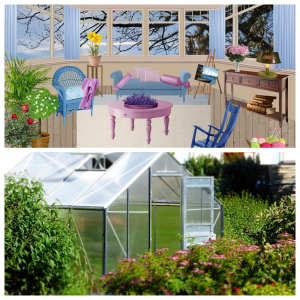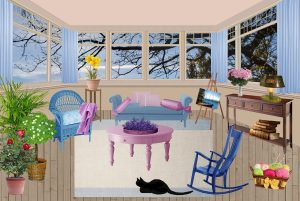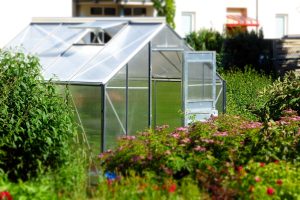Wondering what are Solarium Vs Greenhouse differences ? Well, Solariums primarily offer cozy spaces filled with natural light, perfect for relaxing and caring for indoor plants while On the other hand, Greenhouses primarily provide controlled environments designed for optimal plant growth and extending the growing season.
Solariums beckon with their inviting spaces bathed in natural light, ideal for leisurely moments and nurturing indoor plants.
Conversely, Greenhouses beckon with their promise of controlled environments tailored for optimal plant growth and season extension.
In this article, we explore the 10 best differences between Solariums and Greenhouses, covering everything from their purposes to their construction.
Also check : Can A Greenhouse Be Used As A Conservatory?
Reviews: 10 Best Solarium Vs Greenhouse Differences
-
Solarium Vs Greenhouse Purpose
Solariums: Primarily designed as living spaces or rooms with extensive windows or glass walls, solariums aim to maximize sunlight exposure for relaxation and enjoyment.
Greenhouses: Conversely, greenhouses are structures specifically engineered for growing plants, providing controlled environments for optimal growth, irrespective of external weather conditions.
-
Solarium Vs Greenhouse Functionality
Solariums: These spaces are utilized for leisure, socializing, and enjoying the surrounding landscape while being sheltered from the elements.
Greenhouses: Function as practical spaces for cultivating plants, vegetables, and flowers, offering an environment conducive to plant growth by regulating temperature, humidity, and sunlight exposure.
-
Solarium Vs Greenhouse Construction
Solariums: Typically feature large windows or glass walls on three or more sides to allow sunlight to penetrate, creating a bright and open space.
Greenhouses: Often constructed with transparent or translucent materials like glass or polycarbonate panels, creating a sealed environment that traps heat and sunlight for plant growth.
-
Solarium Vs Greenhouse Temperature Control
Solariums: Minimal temperature control features, relying more on passive solar heating and ventilation systems to regulate temperature.
Greenhouses: Equipped with heating, cooling, and ventilation systems to maintain optimal conditions for plant growth throughout the year.
-
Greenhouse Plant Growth vs. Solarium Human Comfort
Greenhouses: Prioritize creating ideal conditions for plant growth, focusing on factors like temperature, humidity, and light intensity.
Solariums: Prioritize human comfort and enjoyment, providing a space for relaxation, socialization, and basking in natural sunlight without specific environmental controls for plant growth.
-
Solarium Vs Greenhouse Usage
Solariums: Typically used as additional living spaces in residential homes or as recreational areas in public buildings like hotels or resorts.
Greenhouses: Utilized for commercial plant production, research purposes, or by gardening enthusiasts to extend the growing season or cultivate plants with specific requirements.
-
Solarium Vs Greenhouse Aesthetic Appeal
Solariums: Often designed with aesthetics in mind, featuring stylish architecture and landscaping to create visually pleasing indoor-outdoor spaces.
Greenhouses: While functionality is prioritized, many beautifully designed greenhouse structures blend form and function seamlessly.
-
Solarium Vs Greenhouse Cost
Solariums: Can be expensive to build and maintain due to extensive use of glass or other transparent materials and the need for heating, cooling, and ventilation systems.
Greenhouses: Vary in cost depending on size, materials, and complexity, generally focused on practicality and efficiency for plant cultivation rather than luxury or aesthetics.
-
Solarium Vs Greenhouse Maintenance
Solariums: Require regular cleaning of glass surfaces and maintenance of any heating or ventilation systems to ensure comfort and functionality.
Greenhouses: Demand ongoing maintenance to monitor and adjust environmental conditions, along with routine tasks like watering, fertilizing, and pest control to support healthy plant growth.
-
Solarium Vs Greenhouse Regulatory Considerations
Solariums: Regulations typically focus on building codes, energy efficiency standards, and safety requirements for habitable spaces.
Greenhouses: May be subject to additional regulations related to agricultural zoning,greenhouse permit , environmental impact, water usage, and pesticide/herbicide usage, especially in commercial operations.
Potential Drawbacks of Solarium
Solariums, while offering benefits like providing a year-round tan and potentially boosting vitamin D levels, also come with some drawbacks to consider:
- Skin Damage: Excessive exposure to UV radiation in solariums can lead to premature aging, wrinkles, and an increased risk of skin cancer.
- Health Risks: Prolonged use of solariums can contribute to eye damage, including cataracts and corneal burns, as well as weaken the immune system.
- Regulatory Concerns: Many countries have imposed regulations or outright bans on solariums due to their known health risks.
- Dependency: Regular use of solariums may lead to a dependence on artificial UV radiation for tanning, which can exacerbate the health risks mentioned earlier.
- Cost: Purchasing or using solarium services can be expensive, especially considering the potential long-term health costs associated with UV exposure.
- Maintenance: Maintaining a solarium requires regular cleaning and upkeep to ensure safety and effectiveness, adding to the overall cost and effort.
- Inconsistent Results: Achieving an even and desirable tan in a solarium can be challenging, leading to potential dissatisfaction with the outcome.
- Social Stigma: Some people view artificial tanning methods like solariums negatively, which can lead to social stigma or judgment from others.
Considering these drawbacks, it’s essential for individuals to weigh the potential risks against the desired benefits before deciding to use a solarium. Additionally, alternative methods for achieving a tan, such as sunless tanning lotions or sprays, may offer a safer option for those seeking a bronzed appearance.
Potential Drawbacks of Greenhouse
Greenhouses offer numerous benefits for growing plants, such as extending the growing season, providing a controlled environment, and protecting crops from pests and harsh weather conditions. However, there are also some potential drawbacks to consider:
- High Initial Cost: Setting up a greenhouse can be expensive, especially if it includes advanced technology for climate control, irrigation, and monitoring systems.
- Energy Consumption: Greenhouses often require heating, cooling, and lighting systems to maintain optimal growing conditions, which can lead to high energy consumption and increased operational costs.
- Maintenance Requirements: Proper maintenance of a greenhouse, including cleaning, repairing equipment, and monitoring environmental conditions, can be time-consuming and labor-intensive.
- Disease and Pest Management: While greenhouses can protect plants from some pests and diseases, they can also create a conducive environment for certain pests and diseases to thrive if not managed properly.
- Environmental Impact: The materials used in greenhouse construction, such as plastics and metals, can have environmental consequences, including production emissions and waste generation. Additionally, energy-intensive greenhouse operations may contribute to carbon emissions.
- Limited Space: Greenhouses have a finite amount of space, which may restrict the scale of production compared to outdoor farming methods.
- Dependency on Technology: Greenhouse operations rely heavily on technology for climate control, irrigation, and monitoring, which can be susceptible to malfunctions or failures, leading to potential crop losses.
- Regulatory Compliance: Depending on the location, there may be regulations and permits required for greenhouse construction and operation, adding to the complexity and cost of maintaining a greenhouse operation.
- Risk of Overheating or Overcooling: Despite efforts to control the climate, greenhouses can still experience fluctuations in temperature, leading to the risk of overheating or overcooling, which can negatively impact plant growth and productivity.
- Water Management: Efficient water management is essential in greenhouse operations to prevent water wastage and minimize the risk of diseases such as root rot. However, achieving optimal water management can be challenging and may require sophisticated irrigation systems.
Overall, while greenhouses offer many advantages for plant cultivation, it’s important to carefully consider and address these potential drawbacks to ensure the success and sustainability of greenhouse operations.
Solarium Vs Greenhouse Differences FAQ
-
What are the main differences between a Solarium and a Greenhouse in terms of functionality and purpose?
Answer: Solariums are primarily designed as sunrooms or enclosed spaces attached to a house for recreational use, relaxation, and enjoying natural light, while Greenhouses are structures specifically built for cultivating plants by providing controlled environmental conditions for optimal growth.
-
How does a Solarium differ from a Greenhouse in terms of design and construction materials?
Answer: Solariums typically feature large windows or glass walls to maximize sunlight exposure and are constructed with materials like aluminum, vinyl, or wood. Greenhouses, on the other hand, have a sturdier frame and are predominantly made of aluminum or galvanized steel with polycarbonate or glass panels for insulation and light transmission.
-
What are the advantages of choosing a Solarium over a Greenhouse for residential gardening and leisure activities?
Answer: Solariums offer a versatile space for relaxation, entertaining guests, and enjoying indoor plants without the need for specialized gardening equipment. They provide a cozy atmosphere year-round and can be customized to suit various aesthetic preferences.
-
In what ways does a Greenhouse offer superior climate control and plant growth conditions compared to a Solarium?
Answer: Greenhouses provide precise control over temperature, humidity, and ventilation, creating an ideal environment for plant growth, propagation, and experimentation. This controlled climate allows for extended growing seasons and the cultivation of a wider range of plant species.
-
What factors should I consider when deciding between a Solarium and a Greenhouse for extending the growing season?
Answer: Consider factors such as your budget, available space, intended use, desired level of control over environmental conditions, and local climate conditions when choosing between a Solarium and a Greenhouse for extending the growing season.
-
How does the cost-effectiveness of owning and maintaining a Solarium compare to that of a Greenhouse over the long term?
Answer: While Solariums may have lower upfront costs and require less maintenance compared to Greenhouses, Greenhouses offer greater long-term benefits for serious gardeners or commercial growers due to their superior functionality and ability to support year-round cultivation.
-
Can a Solarium be converted into a Greenhouse, or vice versa, to accommodate changing needs and preferences?
Answer: In some cases, it may be possible to retrofit a Solarium into a Greenhouse by installing appropriate climate control systems and modifying the structure to accommodate plant cultivation. However, the feasibility of such conversions depends on factors like structural integrity, available space, and budget.
-
What are the environmental impacts associated with using a Solarium versus a Greenhouse for cultivating plants and vegetables?
Answer: Solariums generally have minimal environmental impact as they utilize passive solar heating and rely on natural sunlight for illumination. Greenhouses, on the other hand, may consume more energy for heating, cooling, and artificial lighting, depending on the climate and cultivation practices employed.
-
Are there specific plant species or gardening techniques better suited for a Solarium compared to a Greenhouse, and vice versa?
Answer: Solariums are ideal for growing houseplants, tropical species, and ornamental plants that thrive in indirect sunlight and moderate temperatures. Greenhouses, on the other hand, are well-suited for cultivating a wide range of fruits, vegetables, herbs, and flowers, including those with specific temperature or humidity requirements.
-
How do location, climate, and local regulations influence the decision to invest in a Solarium or a Greenhouse for agricultural or recreational purposes?
Answer: Consider factors such as available sunlight, temperature fluctuations, wind exposure, zoning laws, building codes, and aesthetic considerations when choosing between a Solarium and a Greenhouse for agricultural or recreational purposes. Local climate conditions and regulatory requirements will also influence the decision-making process.
The Bottom Line
In summary, picking between solariums and greenhouses involves weighing the allure of a sunlit sanctuary of solariums against the precision of a climate-controlled growing space ability of greenhouses .
Whether you prioritize leisurely relaxation amidst lush foliage or aspire to cultivate bountiful harvests year-round,
as Understanding the distinctions between solariums and greenhouses is essential for making informed decisions regarding their construction, utilization, and maintenance.
Take the time to assess your gardening goals, available space, and environmental considerations to make the most informed decision depending on the solariums vs greenhouses difference
Whatever your choice may be, both solariums and greenhouses offer unique opportunities to nurture your connection with nature and unlock the full potential of your green thumb.